Dynamic balance is important for rotating cutters with high speed to decrease the run-out which is caused by centrifugal forces.
Howewver, most ot cutters do not have the mechanism to refine the unbalance.
Generally, there are two methods to refine the unbalance; drilling and inserting set screws.
When drilling is used, the method removes the material from the cutter to refine the unbalance.
However, inserts are changed, the unbalance is also changed.
Thus, the method is not repeatable on one cutter.
When inserting set screws is used, the method is repeatable by exchanging set screws.
However, set screws are glued by on ready-made cutters.
Thus, you can not exchange set screws.
So, we have to make a plan to machine the mechanism to refine the unbalance.
To design the mechanism, it is important to evaluate how much unbalance is refined by the mechanism beforehand.
This calculation function simulate that drilling or inserting set screws are conducted equiangularly.
The central axis is the rotating axis.
When inserting set screws are cunducted, set screws are inserted after screw holes are machined.
Weights of set scerews are controlled by grinding or cutting these set screws.
To evaluate how much unbalance is refined by the mechanism, total unbalances are simulated by combinations of single unbalance vectors.
For example, three set screws are simulated.
At this case, there are three single unbalance vectors, which size is equal to \( U_{s} \).
Interval of each holes are 120 degrees.
Possible recorrectable range of the unbalance shapes the regular hexagon with side length \( U_{s} \)
\( U_{s} \) is shown as follows;
\( U_{s} = M_{s} \times R_{s} \)
\( U_{s} \): Maximum recorrectable unbalance by one hole or one set screw
\( M_{s} \): Maximum variable weight by one hole or one set screw
\( R_{s} \): Radius of centers of gravity of holes or set screws
Follwing graphes are made with \( U_{s} = 1 \).
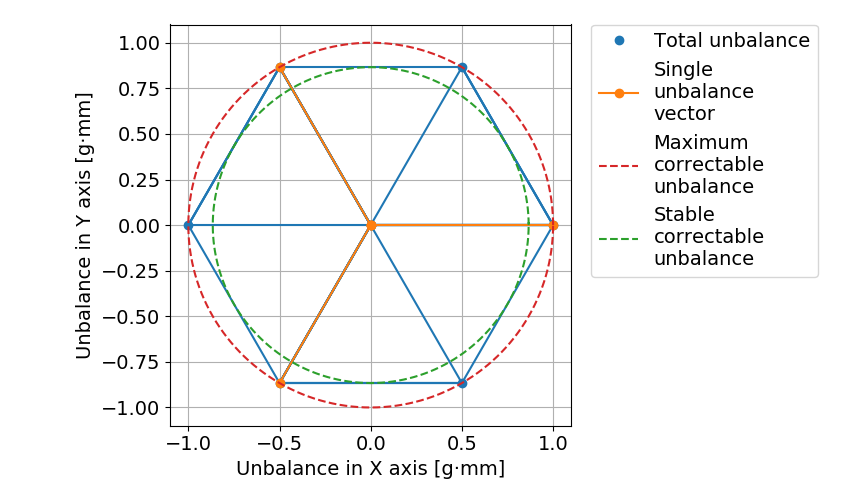
Blue line shows the trajectory which is made by combinations of single unbalance vectors.
Orange line shows single unbalance vector \( U_{s} \) by one hole or one set screw.
Red dotted line: Circumcircle of outer edges
Green dotted line: Incircle of outer edges
Results on other number of holes are shown as follows;
- When four set screws are used,the interval is 90 degrees and the shape is a square with side length \(2 \times U_{s} \).
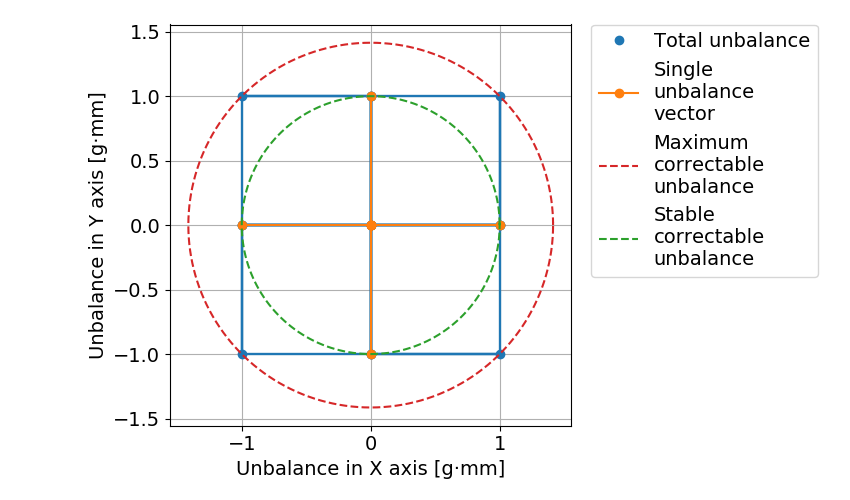
- When five set screws are used, the interval is 72 degrees and the shape is a regular decagon with side length\( U_{s} \).
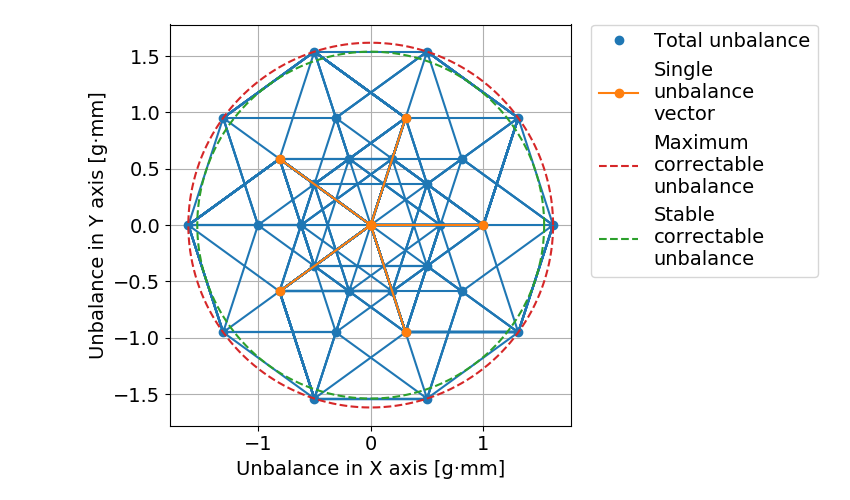
- When six set screws are used, the interval is 60 degrees and the shape is a regular hexagon with side length \(2 \times U_{s} \).
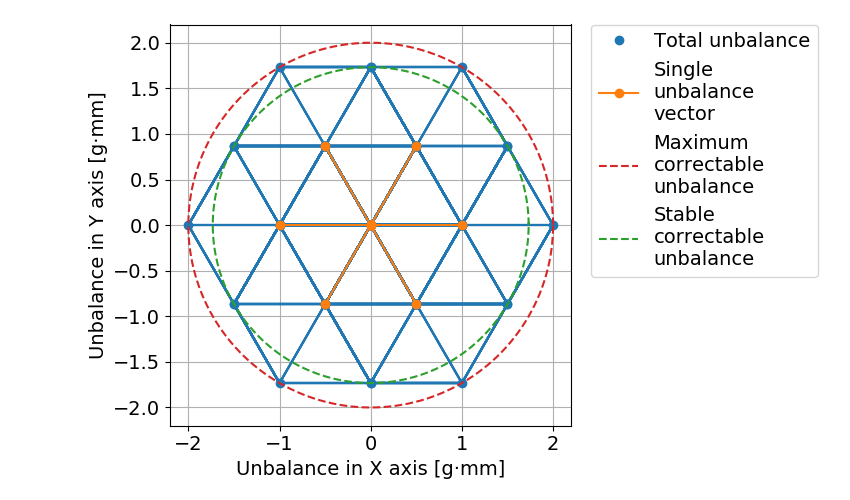
- When seven set screws are used, the interval is 51.42 degrees and the shape is a regular tetradecagon with side length \( U_{s} \).
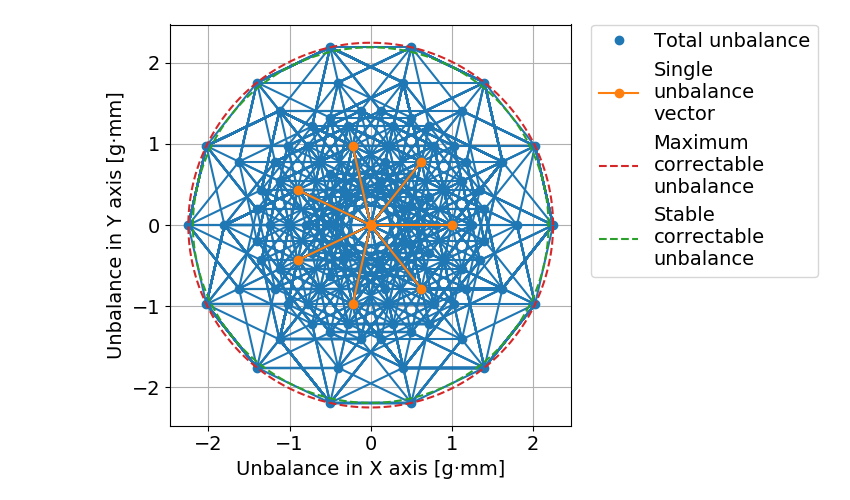
- When eight set screws are used, the interval is 45 degrees and the shape is a regular octagon with side length \(2 \times U_{s} \).
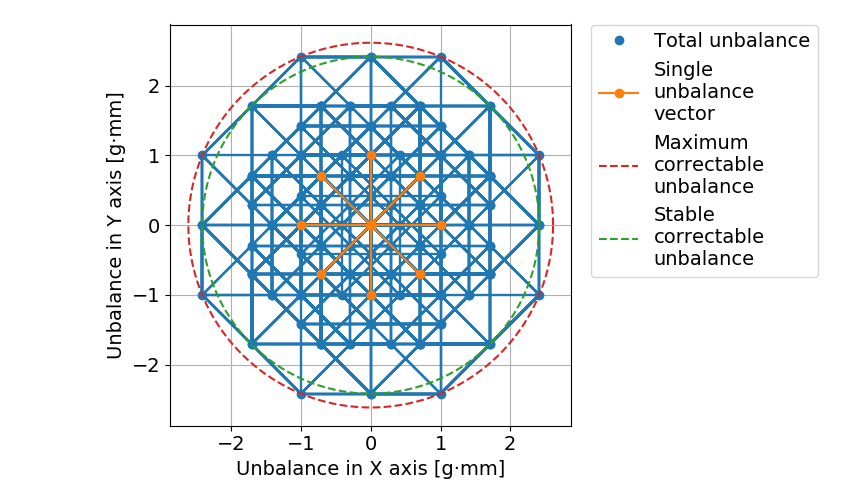
From these results, shapes of recorrectable unbalance are shown as follows;
- When the number of holes or set screws are \(2 \times n \), the shape is a regular \(2 \times n \)-sided polygon with side length \(2 \times U_{s} \).
- When the number of holes or set screws are \(2 \times n -1 \), the shape is a regular \(2 \times (2 \times n -1) \)-sided polygon with side length \( U_{s} \).
Notification: \( n \) is natural number. The number of holes is larger than three.
Maximum value of recorrectable unbalance is equal to the circumradius, because the shape is regular polygon.
The value is defined as the maximum recorrectable unbalance.
This value shows the distance between the center and the apex.
Thus, this value has direction dependency.
Radius of incircle is used to ignore the direction dependency.
This radius is defined as stable recorrectable unbalance.
These two values are shown as follows;
- When the number of holes are \(2 \times n \),
\( U_{max} = \cfrac{ U_{s} }{\sin( \cfrac{ 2\pi }{2 \times 2n})} = \cfrac{ U_{s} }{\sin( \cfrac{ \pi }{2n})} \)
\( U_{stable} = \cfrac{ U_{s} }{\tan( \cfrac{ 2\pi }{2 \times 2n})} = \cfrac{ U_{s} }{\tan( \cfrac{ \pi }{ 2n})} \)
- When the number of holes are \(2 \times n -1 \),
\( U_{max} = \cfrac{ U_{s} }{2 \times \sin( \cfrac{ 2\pi }{2 \times 2 \times (2n-1)})} = \cfrac{ U_{s} }{2 \times \sin( \cfrac{ \pi }{ 2 \times (2n-1)})} \)
\( U_{stable} = \cfrac{ U_{s} }{2 \times \tan( \cfrac{ 2\pi }{2 \times 2 \times (2n-1)})} = \cfrac{ U_{s} }{2 \times \tan( \cfrac{ \pi }{ 2 \times (2n-1)})} \)
\( U_{max} \): Maximum recorrectable unbalance
\( U_{stable} \): Stable recorrectable unbalance